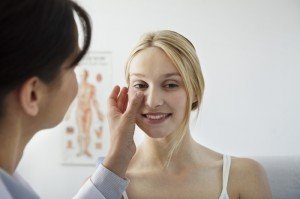 What events precede sinusitis? Usually, in URTI, inflammatory changes in the mucous membrane are observed not only in the nose, but also in the sinuses. Normally, mucus from the sinuses mucous membranes purified from foreign agents, whereas in the closed anastomosis secretion outflow is difficult, broken ventilation and drainage of the sinuses, vary the composition and acidity of the discharge, ciliary epithelium damaged, and self-cleaning mechanism stops functioning. Favorable conditions for the reproduction of viruses and bacteria are created, which contributes to the intensification of the inflammatory process.
What events precede sinusitis? Usually, in URTI, inflammatory changes in the mucous membrane are observed not only in the nose, but also in the sinuses. Normally, mucus from the sinuses mucous membranes purified from foreign agents, whereas in the closed anastomosis secretion outflow is difficult, broken ventilation and drainage of the sinuses, vary the composition and acidity of the discharge, ciliary epithelium damaged, and self-cleaning mechanism stops functioning. Favorable conditions for the reproduction of viruses and bacteria are created, which contributes to the intensification of the inflammatory process.
Symptoms of sinusitis. Unpleasant sensations in the region of the nose or near-nasal region increase gradually. Toward evening the pain is growing. Over time, the pain loses theexact place, and the patient begins to experience pain in the head. If the process is one-sided, then the pain sensations are noted only on one side. Nasal congestion and difficulty in nasal breathing are pronounced in sinusitis. The voice becomes a nasal hue. Both halves of the nose are often incorporated. Nasal breathing is difficult at all times or with little relief. Variable nasal congestion in the left and right half of the nose is not excluded. Runny nose is a key symptom of sinusitis. Quite often, a patient with this problem has mucous or purulent discharge from the nose. Such a symptom may be absent, if the nose is heavily stuffed. A rise in body temperature, usually from 38 to 39 C is observed in the acute form of sinusitis. With chronic sinusitis, fever is rare. Malaise is caused by fatigue and excessive weakness, people refuse to eat, and they have a sleep disorder.
Anti-inflammatory and antipyretic drugs in sinusitis:
Until recently, traditional scheme of treating included the use of nasal vasoconstrictor to reduce the edema and swelling of the nasal mucosa; Aerosol inhalation of antibiotics; Use of physiotherapeutic methods (blue light lamp, solux, UHF currents); Systemic antibiotic therapy; physical methods evacuation of fluid from the sinuses.
Puncture for the treatment of sinusitis:
The method of reconstructing the outflow from the affected sinus by puncture was previously used very widely. Today, it is resorted to much less often. Puncture is performed with the help of a special low-traumatic needle, the pus is removed from the sinus and drug is administered, sometimes a plastic catheter is installed, which allows you to repeat the rinsing regularly without making repeated punctures. The operation on the maxillary sinus is very painful, but it cannot "insure" the patient against recurrences of the disease, so it is not surprising that this procedure has been and remains unpopular among the population. In Europe and the United States puncture treating is rarely used due to the risk of HIV infection, or even viral hepatitis B and C. In addition, in the arsenal of doctors there are many effective drugs for medical treatment.
Antibiotics in sinusitis:
It is also questioned the need of antibiotic. Most often, as one of the typical manifestation is a viral etiology. The use of antibiotics like Amoxicillin (which is mostly used in such case) is advisable only if there are strict indications for their purpose. Also it must necessarily be based on identifying the microorganism and determining its sensitivity.
Vasodilating agents:
The use of nasal vasoconstrictors to reduce edema of the nasal mucosa and restore the outflow of mucous secretions from the paranasal sinuses brings only temporary relief. These drugs with long-term use (more than 5 days) often lead to changes in mucosa of nose (the so-called medicamentous rhinitis) and the development of the addictive effect.
The key to successful treatment of sinusitis is normalization of viscosity and free outflow of secretion. Almost everywhere the main and most important trend in the course is recognized secretolitic treatment prescriptions, which liquefy viscous mucus secretions to normalize mucociliary clearance.
Mucolytic drugs (plant extracts, creosote derivatives, synthetic benzilamiiny, bromhexine, ambroxol) affect the physico-chemical properties of secretion, reducing its viscosity and thus improve the efficiency of mucociliary clearance. The main mechanism of action of secretolithics is to enhance the motor activity of the ciliated epithelium. Normalization of mucociliary transport is key to restore the protective properties of the mucous membrane, olfactory, maintain local immunity, and prevent recurrent diseases. Such preparations based onmedicinal plants have a number of advantages over synthetic ones: they have complex and at the same time soft action, they rarely cause side effects, they can be used for a long time.